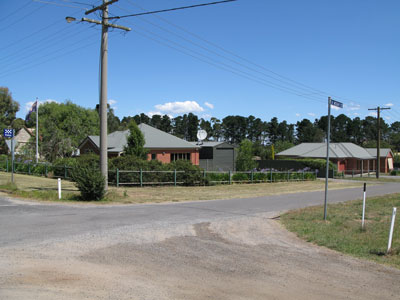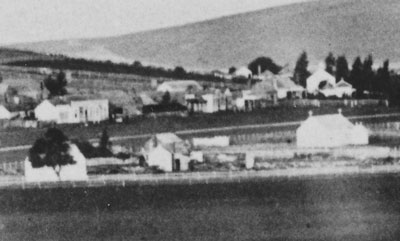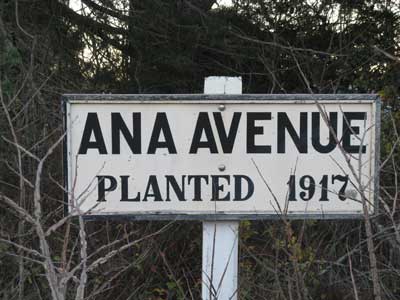| |
30: Spier's Bakery
|
|
|
J. P. Spiers baked bread, biscuits and cakes.
During the 1960s & 70s,operated byKeith Hucker, this was a Mecca for the people of Ballarat and district as the only fresh bread baked on a Sunday.
|
More detail coming soon. |
| |
Return to sites list |
31: Sandlant's Butcher
|
More detail coming soon. |
|
Originally built by Alfred Sandlant as a butcher's shop. He supplied meat to the local townsfolk and also delivered around the district by horse and cart. He later sold the business to the Rasdell Brothers who moved the butchery to their slaughter yard, leaving the little shop empty.
It was later purchased by Mrs. Betts who gave it to "Boota", a former Indian hawker who had previously lived in a hut near Medwell's chaff mill. He conducted a barber's business from here. Following his death Mrs Goad bought the shop which remained closed for many years. In more resent times it has, periodically, been used again as a hairdressing salon.
At present it is being used for making speciality chocolates.
|
|
| |
Return to sites list |
32: W D Sara Saddler
|
|
|
William Dingle Sara came to Learmonth in 1882, setting up business in a shed on this property making and repairing horse harnesses.
William was a community minded man being active on several committees, including being a foundation member of the Learmonth ANA and its first secretary in 1887. He also audited the financial statements for the Learmonth Presbyterian Church for about seven years.
He was the local agent for "The Argus" newspaper & "The Australian Journal" as well as "The London & Lancashire Insurance Co.". Learmonth people in the later part of the 19th century must have been very fond of reading and keeping up with current events, as in 1897 all of the following papers were available from various businesses in the town by subscription: The Argus, The australasian, The Leader, Once a Week, Ballarat Star, The Courier, The Weekly Times and the Southern Cross.
W. D. Sara was the proprietor and publisher of the "Learmonth Thunderer", published on the 24th June 1897 as part of Queen Victoria's Diamond Jubilee celebrations.
When William died at Learmonth on the 6th of June, 1914 at the age of 53 he had been a saddler in Learmonth for 32 years.
|
|
| |
Return to sites list |
33: Showgrounds/Saleyards
|

The Learmonth Police Station & residence which now
occupies the former showgrounds site.
|
Commonly refered to as the Agricultural Reserve.
The Burrumbeet & Lake Learmonth Agricultural Society was one of several such groups that developed in the late 1880s to assist the agricultural districts that developed around Ballarat after the population increase of the gold rushes.
This group had organised district ploughing competitions and a cup that was given by the society to the 1859 winner still exists.
In 1859 the Surveyor General replied to the Rev Mackie of Lake Learmonth re the necessity of a survey and sale of land in Lake Learmonth into small blocks. In Oct of this year, the Committee of Burrumbeet & Lake Learmonth Agricultural Society received a plan of the Agricultural Reserve for the use of the Society until it was needed for other public purposes.
Members of the Ballarat Agricultural Society whose members mainly belonged to the Ballarat District Road Board met with the Burrumbeet & Lake Learmonth Agricultural Society at the Stag Hotel in Mar 1860.
The meeting discussed amalgamation of the two agricultural groups, and a letter from the Board of Works and Survey granted permission of occupancy of the land as requested for the amalgamated societies under the designation of the Ballarat Agricultural Society.
|
|
The Annual Report of the Ballarat Agricultural Society of 1862 states –together with improvements to the Ballarat Show Yards a substantial fence has been erected around the society’s Reserve at Learmonth; the cost of the four rail fence being £64 ($128).
In Feb 1861 a “show of grains” and in September “a show of horse stock was conducted at Learmonth, but most of the time the area was just used for the grazing of stock. Following a show of grain in 1863, a sample of Tartarian Oats shown by Mr Kinnersly of Learmonth was sent to the Great International Exhibition in London.
The reserve was used for many different reasons; not always what it may have been designed for; in 1861 the locals called for the removal of tents from the Learmonth Reserve, which was being used by itinerants. Also this year severe thunderstorms caught two bullock teams camped at the reserve. Four were killed outright and one was crippled.
The first public sale of sheep by district graziers was held in 1865 and by the stock firm, Everinghams in 1866, but the lack of stockyards made selling difficult. Several successful sales were held and some structures were erected suitable for sale yards, but this activity didn’t last for long.
The Ballarat Star Learmonth correspondent in May 1867 wrote – no public use is made of the reserve, though some stock sales were held last year. Presuming the society has no wish to dispose of the reserve, it might, with very little expense plant trees and shrubs, lay out walks, and throw it open to the public; for in hot weather the lake though looking cool and refreshing, has no shelter for pleasure of folks resorting to its shores.
A shearing activity occurred on the reserve in 1871, when local shearer Sam Hodder was declared the winner and received a prize of £3 ($6) from the Agricultural Society. The 1871 demonstration by the Odd fellows Lodge held at the Agricultural Reserve was a gala performance in the Learmonth township. Flags flew on the Reserve and vehicles of all descriptions came from many directions. A procession of three local friendly societies marched through the main street accompanied by the Learmonth Brass Band. A variety of sports including leaping, tossing the caber, putting the stone, and the old Aunt Sally entertained the participants and spectators; the favourite races that day were the hurdles and potato races.
|
When the sports came to a close, most of the company proceeded to the Temperance Hall. Huge crowds attended these activities as they catered for all ages. They were usually followed by a tea at the Temperance Hall or Shire Hall, after which many would stay on for a dance that went into the small hours of the morning.
The lodge members held these demonstrations annually in aid of some charitable institution.
In 1873, the new Learmonth Bowling Club selected a site for their green on part of the Agricultural Reserve; the public was impressed how tidy its surrounds looked.
A similar event to those held by the Learmonth Lodges was held by the local Cricket Club on Boxing Day, 1886 to raise funds for the club. These Boxing Day sports events were probably organised by various clubs. Numerous entries were received for the 1886 games, which comprised 18 different events These included: wheelbarrow race, Siamese race, egg & spoon race, putting 56lb weight, cricketers’ race, sack race, boys’ race, tilting match, high jump and throwing a 14 lb weight. The last event was always catching the greasy pig.
There were two hundred couples present at the dance following this sports day.
By the 1890s, many committee members of the Ballarat Agricultural and Pastoral Society thought the land should be sold and in 1899 the society was informed by the government it would be able to keep the proceeds from the sale of the land. The sale occurred in 1902 and the proceeds of £110 ($220) were received in Feb 1903.
Article researched and written by Mrs Claudette Crick.
|
| |
Return to sites list |
 |
34: St Joseph's Catholic Church
|
History of St. Joseph's Catholic Church
1857 - 1957
By Fon Ryan.
Reproducded from: "Back to" Learmonth and District.
25th to 28th January 1957. Souvenir Programme.
|
 |
|
In the year 1857, a beautiful site on the northern side of the Lake was granted to the Catholics of Learmonth for religious purposes. After a meeting of the district congregation it was desided to build a Church. Among those present on that occasion were: Messrs. W Burke, R Butler, T Cantwell, J., M. and D. Casey, A. and M. Cavananagh, J. Connelly, T. Cashier, D. Direen, P. Donovan, M. Feary, G. Fitzgerald, A. McAuley, J. McNeil, T. McGuire, P. McCarthy, D. Mulcahey, M. Monahan, P. Neary, P. O'Brien, N. Purcell, P. and T. Quinlivan, Martin and Mat. Ryan, M. Riodan, S. Smith, and Mrs. Nolan.
The Church which they erected was a long wooden building. During the week-days it was used for a school. Mr. L. O'Flaherty was appointed school-master in 1859. However, it was not long before the ambitious congregation sought some more lasting and noble expression of their religious beliefs. They decided to replace the earlier wooden building with a substantion brick church. Their faith and zeal were evidenced in the beautiful and commodious Church of St. Joseph's, which now stands on the site of the original building. The design of this Church is by Hansom. Buckley and Sons were the contractors, and Mr. H. R. Cassilli the architect. Dr. Goold, Bishop of Melbourne, laid the foundation stone in 1873. The occasional sermon was preached by Rev. D. F. Barry, O.S.B. The total cost of the church was £3,000. Unfortunately, a cyclone struck the church shortly after its completion. The gable ends were destroyed, but the pioneers were undaunted by the catastrophe. They immediately rebuilt the damaged portions of the church.
Learmonth was originally in the Diocese of Melbourne, but Ballarat was created a diocese on 31st March, 1874, and Learmonth came within the province of the new diocese. the first Bishop of Ballarat, Most Rev. Dr. O'Connor, was consecrated on 17th May, 1874. He died on 14th September, 1883, and was succeeded by Bishop Moore. The next prelate was the Most Rev. Dr. Higgins, and his place was taken by the Most Rev. Dr. Foley who died in 1941. The present Bishop, the Most Rev. Dr. J. P. O'Collins, was appointed to the vacancy. All of these prelates honoured St. Joseph's Church and the devoted congregation by the pastoral visitations.
The interior decorations of St. Joseph's Church were gradually completed, and are now regarded very highly. Two stained glass windows have been erected to the memory of the late Mary Doolan and Charles Coglon.
Many of the pioneers have now passed away, and new members are found among the congregation, including New Australians, who continue to carry on the good work.
So maginificently did the pioneers plan and work that little was left to their successors except to keep in repair the Church building and grounds. In 1912, the choir gallery was erected at a cost of £150. In 1926 the younger members of the congregation erected the Church tennis courts at a cost of £450. The prime movers in this undertaking were Rev. J. Timmins, Mr. P. Donovan and Mr. J. P. Ryan. In April, 1931, the ordination of one of St. Joseph's congregation, Rev. V. Ryan, took place. to celebrate the occasion, a dinner, given by the congregation in his honour, was held in the Mechanics Institute and 250 persons attended, the organisers were Messrs. M. Casey, J. Miller and M. Ryan.
The interior of the Church is well adorned with Statues and Pictures, being often added to by donations from past and present members of the congregation. St. Joseph's Church is still attached to the Ballarat Diocese. At one time there was a movement on foot to make Learmonth a Parish, but it did not eventuate. Many distinguished priets, too numerous to mention, have been in charge of the district, the present one being Rev. T. O'Brien.
Since the brick church was built there have been but three caretakers, Mrs. Stutt, Mrs. Quigley and Miss Quigley, who pasted away in December, 1948. Since then, the ladies of the congregation take it in turn to decorate and keep the church clean, and the condition of the furnishings and the interior of the edifice put the hall mark of distinction on their work.
|
| Return to sites list |
35: Wesleyan Chapel
|

|
|
Some time in 1857 the Wesleyans erected four wooden buildings, including a church.
The Wesleyans, Presbyterians and Roman Catholics conducted the early schools of Learmonth. As far as we know the Wesleyans were the only group to build a timber purpose built school at the same time as building their church.
In Oct 1857 the Wesleyan Minister, Rev. Pickford corresponded with the Board regarding consideration for school funding as the local subscription raised was £208 ($416). 44 children were engaged to attend the school and they intended to accommodate 20 boarders. A grant of £200 ($400) was received.
In Nov 1857 he applied for a higher salary than had been granted for the school teacher.
John Pomeroy was appointed teacher on 1st Jan 1858 and Helen Pomeroy began on1st April.
In Nov 1858, the Presbyterian Church Committee received correspondence from Rev Pickford of the Wesleyan Church. He suggested that as their teacher had resigned his position and that in reorganising the school, it would be desirable for its efficiency that the new teacher be chosen by a united Wesleyan and Presbyterian committee. The new school known as the Lake Learmonth Combined School began on the 8th Jan 1859 with Head Teacher Mr Jonas Horsfall. He remained at the school until 12th Mar 1859, followed by Mr George Crockett.
The Combined School remained at the Wesleyan site until Oct 1860, when it transferred to the Presbyterian Church.
A report by an Inspector Gilchrist in May 1869 said: "There is a building at present employed as a Wesleyan Chapel. The building is of Weatherboard, lined throughout with board and painted within, it is in very good condition, although it had to be propped up at some time. There is on the ground an uninhabited building containing a three roomed cottage and washing shed; there is also a stable."
|
|
Researched and written by LDHS member,
Mrs Claudette Crick
|
Return to sites list |
| |
36: McKay Blacksmith
|
|
The business was owned by William McKay, the paddock (now the football oval) was used to spell the Cobb & Co. Horses.
The blacksmith, William Ryan shod the Cobb & Co. horses as well as being responsible for their general welfare. He also did general blacksmithing work. Cobb & Co. had a booking office at the Stag Hotel which was run by John McPhee.
Sidney Hender was the last blacksmith to work on this site up until the 1950s.
|
The LDHS was unable to locate any photographs of this site.
|
| |
Return to sites list |
37: ANA Plantation
|
|
|
The Learmonth Australian Natives Association Branch No 75 was formed on May 17th 1887, the foundation members being Messrs P. Ryan, president, W.D Sara, secretary, H.Lange, A.Blair, and R.Medwell. Interest quickly spread and by the end of the first quarter, May to August, sixteen names were on the list of members Messrs P.Ryan. W. D.Sara, S. Lynch, T.Dean, C.Kinnersly, A.Sharp, G.Sharp, H.Lange, C.Chisholm, D.Doyle, McKay, R.Medwell, P.McGuire F.Kinnersly, A.Blair, G.Wright.
From the very first meeting it was evident that the Branch not only catered for the medical needs of the community, but also took an active part in all facits of community life.
Sports events were conducted, debates organised, tug-of-war teams formed, and in later years prizes was given by the branch for essay competitions conducted in the schools to celebrate Australia Day, or foundation Day as it was known then. The branch took part in presenting the A.N.A.prize for the best school garden in this area. Members always took a keen interest in local government and parliamentary affairs. The branch joined in celebrations of the A.N.A. at the golden jubilee.
An avenue of trees was planted in 1917 to commemorate 30 years since formation. In 1933 the A.N.A. planted a memorial tree in recognition of the secretarial work done by Mr Michael Casey over a period of 35 years. A plaque was placed on the tree guard at that time, as the tree grew it became necessary to remove the tree guard. The plaque was then placed at the foot of the tree where it remains today.
|

|
| Researched and written by LDHS member Mr. W J Loader. |
Return to sites list |
|
|
|



